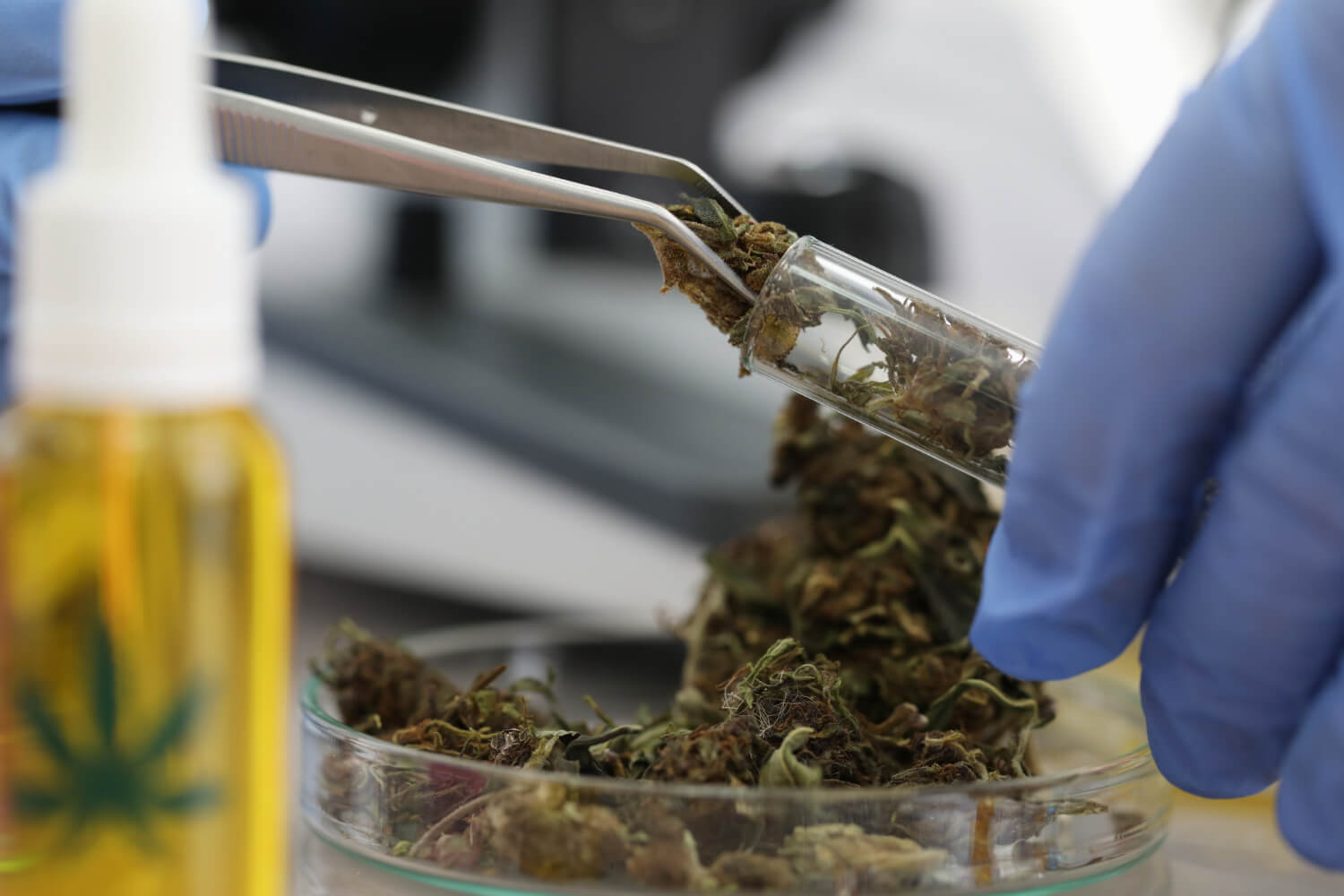Thanks to a group of carboxylic acids that form on the various cannabinoids cannabis creates, to unlock the full potential of its psychoactive and therapeutic compounds, we need to introduce high temperatures to separate the cannabinoids away from these therapeutic-hindering acids. Let’s demystify the mystery behind cannabis decarboxylation in our comprehensive guide.
Understanding Decarboxylation
Simply put, when you want to get high from marijuana flower or want to feel the anti-anxiety and various other effects from CBD products, you have to remove the carboxylic acids from the cannabinoids. You may have heard that it’s pretty much impossible to feel high if you were to eat straight cannabis flower, and this is because of those acids. This is the same reason we slowly cook cannabis flowers when making edibles and why we introduce heat to flowers.
Let’s look at THCa to better understand. When the carboxylic acids are left connected to THC, making it THCa, its molecular structure largely prevents it from binding to CB1 receptors, preventing THC from causing its various effects, from euphoria to hunger. Now, this does not mean, THCa, CBDa, etc., are totally useless, as research has found that THCa has anti-inflammatory and neuroprotective properties along with the ability to reduce nausea and vomiting.
To get a little more complex, carboxylic acids are organic compounds where a carbon (C) atom is bonded to an oxygen (O) atom by a double bond and to a hydroxyl group (―OH) by a single bond. This gives cannabinoids an extra “tail” that prevents them from binding to cannabinoid receptors in the body.
The Decarboxylation Process
The decarboxylation process technically starts when the cannabinoids are still developing on the plant, as intense light and temperatures will encourage the cannabinoids to lose their carboxylic acids. However, it’s very minimal as the cannabinoids have boiling points, with most not occurring until they reach 200°F.
When combusting cannabis by introducing fire, the decarboxylation process is nearly instant as the cannabinoids are introduced to temperatures that easily surpass their various boiling points. However, studies have found these high temperatures can result in a potential loss of up to 70% of the original cannabinoids and terpenes. Vaping is nice in this regard because many vape rigs come with temperature control that allows you to slow down the decarb process.
Step 1. Preparation
Whether you’re decarbing in the oven or with a vape rig, always start with a flower that has been properly dried and cured. Make sure to break the buds down into even pieces.
Step 2. Temperature
When you can slow the decarb process down, you are able to better protect the cannabinoids from excessive heat that can destroy them. So start low and slow, with a starting temperature around 200°F when decarbing in the oven. When vaping, start at the lowest setting and work up until you find the sweet spot.
Step 3. Time
The lower your temperature, the longer it’s going to take to optimally decarb. When your oven is at 220°F (105°C), THC-rich strains typically need 30-45 minutes, while CBD-rich strains may take 60-90 minutes at 203°F.
Step 4. Equipment Needed
When decarbing to make edibles, you’ll need an oven or another cooking vessel that allows precise temperature control. I recommend multiple thermometers and recalibrating your oven, etc.
Step 5. Monitoring
It’s always important to monitor your flowers, even when using a fast decarbing method, stirring whenever needed to equally expose the flower to heat. Perfectly decarbed flower will lose its green color and replace it with a medium-light brown color.
Decarboxylation for Edibles and Oils
When it comes to decarbing, you’ll hear the term most when it comes to making edibles and oils. The big reason for this is due to the time it takes to decarb when making edibles vs. other methods that are nearly instantaneous compared to the hours-long process it takes for edibles/oils.
I personally find the slow decarboxylation when making edibles both frustrating and fun. Because while you can slowly decarb at low temperatures that better protect the cannabinoids, it’s much easier to cut the process short, leaving you with a flower that doesn’t reach its full potential. And while you’ll need to experiment with different temperatures and durations, I have a lot of tips that can help you.
Tips for Consistent Potency and Effectiveness
- Temperature Control: Use a reliable oven with precise temperature control. I greatly recommend having on hand a kitchen cooking thermometer to ensure you’re hitting optimal temperatures. This can additionally help you locate hot and cool zones in your oven. For THC activation, aim for around 220°F (105°C), to better protect sensitive cannabinoids such as CBD, slightly lower temperatures to around 203°F (95°C).
- Breakdown Buds Evenly: You should break your bud down into uniform particle sizes to promote consistent heat distribution during decarboxylation. You don’t need to go as far as grinding them, in fact, I wouldn’t suggest it for various reasons, mostly because the small sizes are easier to fly around in the oven.
- Monitor Time: Keep a close eye on the duration to avoid over-decarboxylation, which will destroy cannabinoids, and under-decarboxylation, which results in reduced potency. Set timers and keep a log to track.
Advanced Decarboxylation Techniques
There are a few advanced decarboxylation techniques you can implore. However, some of these can be complex or involve expensive equipment, while others can result in potency loss if you’re not careful, so don’t take too much on your first time.
Decrease Oxidation
Oxidation happens when the flowers are exposed to light and heat, so make sure your lights are off and you turn your convection oven fan off when decarbing.
Freezes The Trichomes
After your cannabis flower has had time to cool after decarbing, you have the option to freeze the flowers for 24 hours. Doing so may enhance access to these compounds when you go to extract the cannabinoids, which is traditionally done with a fat or solvent.
Hiding The Smell
Decarbing cannabis can get smelly fast, especially when you slow the decarbing process down as much as possible. A sous vide machine can greatly help with both of those! Now you can also simply place your flowers in a mason jar or food-safe plastic bag and submerge it in water for several hours, but many report loss of flavor and potency.
Take Your Time
If you can store your flowers in an air-tight container and limit exposure to light, the cannabinoids will naturally decarb. However, this process will take a couple of years and can result in potency loss due to oxidation.
Safety and Best Practices
Decarbed cannabis, especially when turned into edibles afterward, immediately becomes a safety concern when it’s exposed to kids and pets. Keep cannabis in a secure, child-proof container in a cool, dark place. Store any infused products in clearly labeled containers, away from children and pets.
Even in states where marijuana is legal, many lawmakers are concerned about the sale of food-infused cannabis items, so please familiarize yourself with your laws and stay up-to-date on them.
When decarbing cannabis flowers, please discharge any flower contaminated with mold or pests. Wearing gloves is a good idea to minimize skin contact that can pull the trichomes off the flowers. Additionally, make sure you have oven mitts or heat-resistant gloves to avoid burns when decarbing in the oven, etc.
Last, but not least, while it’s smart to reduce oxidation by turning off your oven fan and keeping the flower as sealed as possible, you should decarb in a well-ventilated area or use a dedicated ventilation system to dissipate any potential fumes.
Conclusion
While a seemingly simple but crucial process, we learned a lot about cannabis decarboxylation, so let’s summarize the key points.
- When we want to unlock the full potential of cannabis, the flowers will need to be decarbonized due to cannabinoids, a group of acids that largely prevents them from interacting with the endocannabinoid system (ECS).
- To optimally decarb cannabis, the cannabinoids need to be carefully exposed to temperatures, starting around 200°F.
- Decarbing through combustion can result in you losing more than half of your cannabinoids due to high temperatures. To avoid this, many are moving to edibles that use a slow decarb process or vaporizer rigs with temperature controls.
- Before decarboxylation, cannabis doesn’t pose much of a threat to children or pets if accidentally consumed. However, the same cannot be said once it is; please store decarb cannabis away from kids and pets.
Feel free to experiment with various temperatures, times, and equipment as everything from moisture to flower density can affect decarboxylation rates. I highly recommend keeping a log on hand, while always following your local laws.





